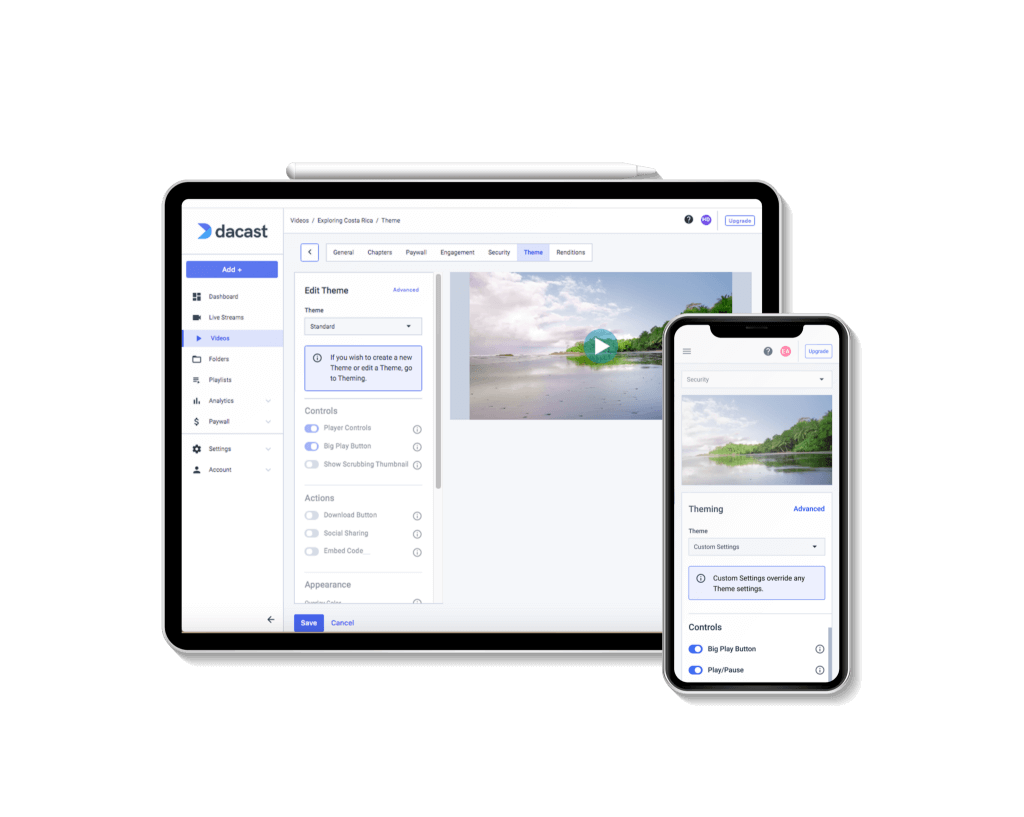Top 15 Reasons Why You Should Never Self-Host Your Videos
As a business, you have a plethora of options when it comes to hosting and sharing video files. You can use free platforms such as YouTube, opt for paid software, or do self-hosted videos. For many businesses, self-hosted video is the best option. By hosting videos themselves, businesses have a greater level of control over their content and can upload videos without worrying about a platform’s rules. However, to host your own videos, businesses typically need more technical expertise, time, and resources. This means it’s not always the best option.
In this post, we cover self-hosted video hosting and the reasons why it’s not the best option for many companies. We also provide you with some premium, private video hosting platforms that businesses can use instead.
Table of Contents
- What is Self Video Hosting?
- Benefits of Self-Hosting Videos
- 15 Reasons Self-Hosting Video is a Bad Idea
- Artificial Intelligence in Self-Video Hosting
- Technical Advancements in 2024–2025
- Latest AI and Machine Learning Features
- Features and Pros and Cons of Self-Hosting
- Comparing Self-Hosting With Third-Party Platforms
- Cost Comparison Between Self-Hosting and Third-Party Platforms
- Trends in Video Hosting Technology (2024–2025)
- Sustainability and Environmental Impact
- Success Stories and Pitfalls
- AI-Related Technologies for Video Hosting
- How These AI Tools Make Self-Hosting Viable
- Case Studies
- Actionable Insights
- Why Not to Self-Host Without a Professional Platform
- The 10 Top Self-Hosting Video Platform Alternatives
- Conclusion
What is Self Video Hosting?
Self-hosting your video content means that, not only do you create the video content yourself, but you also manage the infrastructure to store the videos, post them online, and promote them to your audience. With video self-hosting, you take care of everything related to your content.
Hosting your videos requires a massive amount of time, money, and knowledge, as you need to maintain ample storage for all the video content, and protect the videos from illegal access. With video self-hosting, you take on all the responsibility for managing and protecting your video content.
Benefits of Self-Hosting Videos

Self-hosting video content is attractive to businesses that want control over their videos.
Self-hosting video, when done correctly, provides businesses with a variety of benefits, including:
- A higher degree of control over how your content is used: Depending on the third-party hosting setup you select, your video content — and how that content is used — can become the property of the platform you utilize. Self-hosting video allows you to maintain complete control over your videos and how they are shared.
- More control over how your videos look: Some third-party hosting platforms, such as YouTube or Facebook, do not offer the option to remove their branding. Businesses that want to be able to completely brand their video content may elect to self-host.
- Drive more traffic to your sites: When you host your videos and embed that content on your website, you’re making sure that anyone who watches your content stays on your website instead of being sent to a different website.
While these benefits, for many businesses, are enough reason to go to the difficulty and expense of self-hosted video content, many find that the drawbacks don’t outweigh the positives enough. Video self-hosting provides many benefits, but requires a lot of technical knowledge and know-how.
15 Reasons Self-Hosting Video is a Bad Idea
Hosting your video content can provide you with a great deal of control over your content and how it is presented.
However, it also can be an incredible headache and an expensive venture, making it less appealing to smaller businesses than it would be for larger enterprises with a lot of content.
When considering whether or not to host your video content, here are 15 reasons you may find that self-hosted video is a bad idea:
1. Your Server’s Bandwidth
Video files can easily be large, typically clocking in at more than 100 MB.
If you host multiple large videos and have a few dozen people all trying to watch the same video at a time, it can put quite a strain on the bandwidth allocated to you by your internet provider.
Your provider gives each live streaming server a specific amount of bandwidth and resources, using average traffic rates that do not include streaming large media files to multiple viewers at the same time when calculating that number.
If your self-hosted video servers are sent too many requests for a single large file, you quickly will exceed the limits of the server on which your site is hosted and bring your website to a screeching halt.
You will need to purchase more bandwidth from the website’s hosting provider to support hosting your videos.
2. Limits on File Size and Storage Space
In some cases, your server bandwidth limits will be the least of your problems, as you won’t even be able to upload your videos to your self-hosted video server in the first place.
To keep demands on shared servers low, many web providers limit the file size individual users can upload, often 50 MB or less. If a video file is, at minimum, 100 MB, that means you won’t be able to upload even a single video file without paying extra or finding an alternative.
In addition to simply being unable to upload files due to limits, self-hosting your video means backing up your website and its contents takes much longer.
This limits the number of times your host can back up your website, making it more vulnerable to crashes and hacking, and increases the chances that some of the data you need to be backed up becomes corrupted.
You will have to be careful about how large your videos are and ensure that they work with the file limit size of your website host.
3. Longer Page Load Times

Large embedded videos can slow down page loading, chasing away viewers.
Embedding your video content on your website pages means that each page with a video will take longer to load.
Because your pages are sending more data from the self-hosted video server to end-users, that’s more that needs to get from Point A to Point B, and there’s more risk of a bad internet connection causing a page to load slowly.
And, when website pages load too slowly, users get frustrated and abandon their view, costing you visitors and, potentially, money. Viewers may not even see your videos when you use video self-hosting if your pages take too long to load.
4. No Single Standard File Format
While many video players are moving toward an HTML5 format, there is no standardized file format prescribed for all browsers.
This means that one user’s browser or device may play MP4 videos, but not videos in WebM or Ogg formats. And another may play Ogg and WebM formats, but not MP4 videos.
Because of this, self-hosting your video means you must have three separate videos uploaded — one in .mp4, one in .ogv, and one in .webm — to ensure that your videos will be playable on all major browsers. This complicates your video upload strategy, while also, at minimum, tripling the amount of bandwidth and server space you must utilize for one video.
Changing the format of your videos and uploading multiple versions with video self-hosting can be time-consuming.
5. Video That’s Slow to Load
If your video is hosted on a single server, that means all queries for your content are sent to the same place. So, if you have a dozen users attempting to watch the same video, that’s 12 individual queries sent to one server.
This creates a bottleneck on your self-hosted video server’s bandwidth, meaning someone is going to fall victim to a slow-loading, laggy video.
With video self-hosting, you need to pay for a lot of bandwidth if you want to ensure a good viewing experience for your viewers.
6. Much More Work for You
With users watching videos on a variety of different devices and using different browsers, that means video files must be playable in all those formats.
For viewers watching on desktop or laptop computers using high-speed internet, you need to serve a large file so they can watch it full-screen without compromising quality. For this, you need to upload a file in 1080p or 720p at a high streaming video bitrate.
Users who wish to watch your videos on mobile devices, need to offer a smaller, lower-resolution version that is suited for smaller screens and slower internet connections.
In addition, because there are multiple browsers, you also must upload different file types, with individual files in each format.
Once all is said and done, you could easily have to create a handful of versions of the same video, decreasing self-hosted server space and costing you money.
That is a lot of work to engage in video self-hosting.
7. Multiple Video Players

By using HTML5, developers no longer worry about which browser or which extension their visitors use.
To play video on your website, you will need to install a video player. These web software solutions automatically detect which device is requesting a video and that device’s connection speed, serving up the correct version of your content to the user.
There are dozens of video players available on the internet, and you’ll need to research and choose which one will work best for your site’s needs. This task can be daunting if you don’t know a lot about video players, or your website, meaning you either have to spend the time brushing up on the subject or you have to pay someone to decide for you.
8. Clunky Code
Once you choose a video player, you need to embed its code into your website using a plugin or other method.
For these players to work properly, you need to create a piece of code that tells the video player which formats you’ve created and where on the self-hosted video server they are located. This takes time and effort and, as with any code, one wrong letter or number and can break the whole thing.
9. Increased Costs
Hosting your own videos means you’re handling a lot of extra tasks and data that you might otherwise hand off to a third-party self-hosted video platform.
When creating and uploading your videos, you have to convert one video into multiple file sizes and formats. This takes time and knowledge, costing money either for you to tackle these tasks yourself or for you to pay someone to do them for you.
Additionally, all those extra versions of one video take up a lot of server space and bandwidth, meaning you may have to pay extra to continue using your current web host.
For many small and medium-sized businesses, these costs quickly balloon out of control and make creating videos less appealing from a business standpoint.
10. Multiple Video Conversions
Creating multiple file sizes and formats means you have to take your one finished video and convert it multiple times.
This requires extra time and special software and also creates the risk that your video will become corrupted during the conversion process.
11. Decreased Traffic

If you’re used to hosting your video using a third-party platform, chances are your video traffic got some measure of the boost from the platform’s promotion.
Having your video pop up in users’ related video suggestions meant more eyes on your videos and, in turn, could mean more money for your business.
By moving all your video away from these self-hosted video platforms and hosting it on your site, you are more reliant upon people arriving on your website and only your website for video views. This could cause your views to decrease significantly.
12. More Complicated
Managing all the individual tasks of creating, uploading, hosting, and promoting your video content just increases the complexity of your whole operation.
And, unless you have someone on your team with knowledge of every piece of that process, you either will have to spend time learning to fill in the gaps or pay an outside person to handle the tasks you can’t perform.
13. Risk of Piracy
Your video content is valuable to your business. And if it’s valuable to you, that means someone, somewhere, may be willing to steal it to make some money.
Hosting your videos leaves you more open to potential nefarious downloads if your security isn’t air-tight. With self-hosted video, you need to learn how to implement security measures such as domain restrictions, password protection, and other security measures on your own.
14. Decreased Promotional Options
Driving new users to your videos can sometimes feel like an uphill battle.
When you’re self-hosting your video content, that battle becomes a little more difficult, as you no longer have some of the built-in promotional options afforded by some third-party platforms.
Rather than having your videos potentially show up in a suggested watch list, you are in charge of drawing every visitor to your website and showing them your videos.
15. Varying Video Quality

Converting and hosting your videos can mean your viewers are subjected to varying video quality, leading to a bad experience for some.
The video conversion process varies from conversion platform to conversion platform. This leaves you with video files that, potentially, don’t play well on certain browsers or devices.
Converting all your video formats on your own can net you video files that look grainy or low-quality on one browser, but that look great on another. Getting the files to all look as they should on every device and in every browser requires endless fiddling with conversion settings and checking and re-checking each format and file size for quality.
Artificial Intelligence in Self-Video Hosting
Artificial intelligence (AI) is increasingly shaping how businesses manage and distribute video content. While AI offers powerful tools for analyzing viewer behavior, automating video tagging, and optimizing delivery, integrating these features into self-hosted video platforms can be a challenge for businesses.
When choosing to self-host videos for business, incorporating AI requires significant investment in both technology and expertise. Unlike dedicated video hosting solutions for businesses that come with built-in AI tools, self-hosted video platforms often demand custom development. This can increase costs and complexity, making it harder to realize the full potential of AI.
AI’s benefits, such as personalized recommendations and advanced analytics, are easier to access with private video hosting solutions. These platforms are designed to leverage AI effectively, providing insights and tools that enhance viewer engagement. On the other hand, the pros and cons of self-hosted video suggest that while self-hosting might offer more control, it often lacks the sophisticated AI capabilities of third-party platforms.
For businesses exploring video hosting options, evaluating AI’s role is crucial. Understanding how to self-host videos for business and the limitations of self-hosted video for AI integration can help in choosing the best solution.
Technical Advancements in 2024–2025
Technical Advancements in 2024–2025: Enhancing Video Hosting
AI-Powered Video Management:
Modern AI tools are transforming business video hosting options. With capabilities like automatic encoding, transcoding, and multi-format file preparation, businesses can streamline workflows and reduce manual effort. AI-powered video search engines improve discoverability in large video libraries, making it easier to locate content efficiently. Additionally, AI-driven predictive analytics help optimize bandwidth and storage requirements, offering insights that reduce the cost of self-hosting videos.
Edge Computing and CDN:
Edge computing and Content Delivery Networks (CDNs) are crucial for improving video delivery performance, especially for those exploring DIY video hosting for business. By minimizing latency, these technologies ensure smoother streaming, even for enterprise video hosting solutions with high traffic demands.
Cloud Storage Innovations:
Hybrid cloud solutions offer scalability while maintaining control, making them a viable alternative to private video hosting for businesses. Low-latency cloud options cater specifically to video hosting server requirements, providing faster access and reliability.
Web3 Technologies:
Emerging decentralized hosting platforms, such as IPFS, are reshaping the landscape for self-hosted video for business. These technologies promote increased privacy and ownership, offering innovative alternatives to traditional best practices for self-hosting video.
Latest AI and Machine Learning Features
AI-Driven Personalization
Third-party video platforms leverage AI to create highly personalized user experiences. By analyzing viewer preferences, AI generates tailored recommendations and interactive elements that keep audiences engaged. This is a key reason why businesses should avoid self-hosting video, as self-hosted solutions typically lack such advanced capabilities.
AI in Content Protection
Protecting video content from piracy is a critical challenge for businesses. AI-powered tools on third-party platforms help detect and prevent unauthorized downloads, providing an effective solution to the question of how to protect self-hosted videos from piracy. In contrast, self-hosted setups often require extensive resources to achieve similar protection.
Video Metadata Automation
Tagging and organizing videos manually can be time-consuming, especially with increasing bandwidth requirements for hosting video content. AI tools on third-party platforms automate metadata creation, making video management more efficient. When comparing self-hosting vs third-party video platforms, this feature underscores the advantages of outsourcing video hosting.
Features and Pros and Cons of Self-Hosting
Features of Self-Hosting Videos
Video Compression Technologies
Self-hosting videos often involves using modern compression algorithms like AV1, which significantly reduce bandwidth usage while maintaining high-quality video playback. These technologies are essential for businesses looking to manage large video libraries efficiently, particularly when considering how to host videos on your website for business.
User Experience (UX) Features
Customizable video players can enhance user experience with features like subtitles, audio descriptions, and playback speed controls. These options cater to a diverse audience, making the benefits of self-hosting videos for small businesses more appealing when focusing on accessibility and branding.
Cons of Self-Hosting Videos
Ongoing Maintenance Challenges
Maintaining a self-hosted video platform requires regular updates to ensure compatibility with new browser versions, device specifications, and emerging technologies. This adds to the challenges of hosting your own video content and can strain resources for small businesses.
Cybersecurity Risks
Self-hosting exposes video data to cybersecurity threats like ransomware attacks. Implementing encryption and AI-based anomaly detection can mitigate these risks, but they often increase costs, making affordable video hosting options for small businesses harder to achieve.
Environmental Impact
Self-hosting large video libraries contributes to a significant carbon footprint due to server energy consumption. Opting for sustainable hosting solutions or exploring alternatives to self-hosting videos for businesses can reduce environmental impact while ensuring reliable service.
Comparing Self-Hosting With Third-Party Platforms
Here’s a clear table comparing self-hosting and third-party video platforms across key criteria:
| Criteria | Self-Hosting | Third-Party Platforms |
| Costs | High upfront costs for servers, bandwidth, and maintenance; ongoing expenses. | Subscription-based pricing; predictable and often more cost-effective for businesses. |
| Features | Limited advanced features; requires custom development for AI or personalization. | Offers advanced features like AI-driven personalization, content protection, and automated metadata tagging. |
| Scalability | Challenging to scale with growing bandwidth requirements for hosting video content. | Easily scales to accommodate large audiences without additional infrastructure investment. |
| Ease of Use | Requires technical expertise for setup and maintenance. | User-friendly platforms with intuitive dashboards and minimal technical knowledge required. |
| Security | Businesses must develop custom solutions to protect self-hosted videos from piracy. | Built-in tools for encryption, access control, and AI-driven piracy detection ensure robust content protection. |
This comparison highlights why businesses should avoid self-hosting video and opt for third-party platforms for better efficiency and performance.
Cost Comparison Between Self-Hosting and Third-Party Platforms
When you self-host videos, the initial and recurring costs can quickly add up. Initially, you’ll need to invest in a reliable server, which can be expensive, especially if you’re hosting large video files. You also need a robust content delivery network (CDN) to ensure smooth playback for users across different locations. These services can come with a significant setup fee.
Recurring costs include server maintenance, bandwidth fees, and storage charges, which can rise as your video content grows. On top of that, the technical expertise required to manage everything can also incur additional costs. In comparison, using a video hosting platform or a video hosting site can help reduce these costs by offering scalable solutions that take care of maintenance, bandwidth, and storage, allowing you to focus on creating content rather than managing infrastructure.
Trends in Video Hosting Technology (2024–2025)
As video hosting technology continues to evolve, new trends are reshaping how videos are stored and delivered. AI is becoming an essential tool for improving video quality and user experiences, offering features like automatic optimization and content recognition. Edge computing for self-hosted videos is also gaining momentum, enabling faster delivery by processing data closer to the viewer’s location. This reduces latency and improves streaming performance.
Meanwhile, scalable video hosting with cloud technology offers businesses flexibility, allowing them to easily manage traffic spikes and large video libraries without compromising performance. These advancements are making it clear that traditional self-hosting may no longer be the best option, especially as new technologies make video delivery faster and more efficient.
Sustainability and Environmental Impact
Self-hosting videos can have a significant environmental impact due to the energy required for storing, processing, and delivering large video files. Data centers used for self-hosting consume a lot of power, contributing to higher carbon emissions. With increasing video content, this energy use can add up quickly, resulting in a larger ecological footprint.
To offset these effects, consider using video hosting platforms that prioritize energy efficiency and renewable energy sources. These platforms often use optimized server networks and sustainable practices to reduce the carbon footprint. By choosing a green hosting option, you can minimize environmental impact while still delivering quality video content.
Success Stories and Pitfalls
When considering self-hosting videos, businesses have seen both success and failure. For example, a small startup decided to self-host their video content to save costs but soon found their website crashing due to high traffic. They lacked the infrastructure to support growing demand, which hurt their user experience and brand reputation.
On the other hand, large companies using advanced video hosting technologies in 2024 have seen impressive results. With AI-powered video security for businesses, they can ensure content is protected while offering seamless streaming experiences. One such success story involves a leading e-learning platform that incorporated self-hosted video with AI integration to optimize user engagement and improve content delivery speed.
The key lesson here is that while self-hosting might seem cost-effective, it often requires significant resources and expertise. Leveraging modern video hosting solutions can help businesses avoid pitfalls and scale effectively in today’s competitive digital landscape.
AI-Related Technologies for Video Hosting
1. AI-Powered Video Encoding and Transcoding
AI technologies like NVIDIA’s Deep Learning Super Sampling (DLSS) optimize video encoding and transcoding. These algorithms enhance video quality while reducing file sizes and bandwidth usage. Adaptive bitrate streaming powered by AI ensures smooth video playback, even with fluctuating internet speeds.
2. AI for Metadata Tagging and Content Management
AI tools, such as Google Video AI or Amazon Rekognition, automate the process of generating metadata like object tags, scenes, and keywords, improving searchability and video organization. AI-driven content categorization helps businesses efficiently manage vast libraries of videos.
3. Content Delivery Optimization
AI models integrated with Content Delivery Networks (CDNs) monitor real-time traffic patterns, optimizing video delivery routes. This reduces latency and buffering, ensuring a better experience for users. Predictive analytics can also help allocate bandwidth during peak traffic times to prevent interruptions.
4. AI-Enhanced Security
AI-driven cybersecurity tools detect piracy, unauthorized access, and DDoS attacks. Technologies like watermarking detection and real-time threat monitoring help safeguard videos. Behavioral analytics can automatically flag suspicious activities, ensuring greater protection for hosted content.
5. AI-Powered Personalization
Machine learning algorithms analyze viewer preferences and behavior, offering personalized video recommendations similar to platforms like Netflix. Dynamic user interfaces can adjust video quality and recommendations in real-time, tailoring the experience to individual viewers.
6. AI for Audience Insights
AI tools analyze engagement metrics such as heatmaps, play rates, and viewer demographics to uncover trends. Sentiment analysis from viewer comments or feedback helps businesses understand audience reactions and optimize content strategies for better performance.
7. AI-Based Video Search and Retrieval
Natural Language Processing (NLP) enables advanced video search capabilities, allowing users to search for specific scenes, phrases, or even objects in videos. This makes it easier for viewers to find exactly what they’re looking for.
8. Automated Video Editing and Post-Production
AI editing tools like Runway AI and Pictory can automatically create shorter clips, highlight reels, or trailers from longer videos. These tools are perfect for tailoring content for different platforms or target audiences with minimal effort.
9. AI for Interactive and Shoppable Videos
Interactive overlays powered by AI allow viewers to engage directly with products featured in videos. These interactive elements improve viewer engagement and open up new monetization opportunities by allowing direct purchases during video playback.
10. AI in Video Monetization
AI algorithms are used to insert personalized ads within videos, making ad content more relevant to viewers. This increases ad revenue while minimizing viewer disruptions, ensuring ads are placed effectively to maintain user engagement.
11. Synthetic Media and Virtual Production
AI-powered tools like DeepMotion and Synthesia enable businesses to create synthetic presenters or avatars, reducing production costs while maintaining video quality. These technologies also help generate realistic voiceovers, making video production more cost-effective.
12. AI-Powered Compression Algorithms
AI-driven compression algorithms, such as AVIF, drastically reduce file sizes without compromising video quality. These innovations help lower storage and delivery costs, making video hosting more efficient and scalable.
13. Real-Time AI Translation and Subtitling
Tools like Rev AI and Otter.ai provide real-time transcription and translation services, allowing businesses to cater to global audiences. These AI tools create live subtitles and multi-language translations, improving accessibility and viewer reach.
14. AI-Driven Predictive Maintenance for Servers
AI systems monitor the health of video hosting servers and predict potential failures before they occur. This proactive approach ensures uninterrupted video streaming and helps businesses avoid downtime, enhancing the user experience.
15. AI-Based Audience Retargeting
AI algorithms analyze viewer data to identify users who abandoned videos mid-way. These insights help businesses retarget those viewers, increasing conversion rates and encouraging sales or subscription sign-ups.
By leveraging AI-powered technologies in video hosting, businesses can improve performance, security, and user experience, making it clear why self-hosting videos may not be the best option.
How These AI Tools Make Self-Hosting Viable
Cost-Effectiveness
AI technology significantly reduces the need for manual labor in tasks like transcoding, metadata management, and content tagging. By automating these processes, businesses can lower operational costs and streamline their workflows, making self-hosting more affordable compared to traditional methods.
Scalability
As your business grows, so do your video hosting needs. AI helps optimize infrastructure usage by predicting traffic patterns and adjusting resources accordingly. This ensures your video platform remains efficient and responsive, even as the demand for content increases.
Improved Viewer Experience
AI-driven personalization allows for tailored content recommendations, while adaptive streaming ensures smoother playback across various devices and internet speeds. This enhances viewer satisfaction and engagement, making the self-hosted solution more appealing to users.
Competitive Edge
Self-hosted video platforms can gain a competitive edge by incorporating AI-backed features such as interactive videos, predictive analytics, and advanced security measures. These innovations not only improve user experience but also provide valuable insights and added protection for your content.
Case Studies
Here are some case studies from businesses that attempted to self-host videos highlight significant challenges.
For example, a startup in the e-commerce space tried hosting product videos on its own servers, only to experience slow load times and increased bandwidth costs. As a result, customers became frustrated, leading to lower conversion rates.
Another company in the education sector used self-hosting for instructional videos. While initially cost-effective, they found that maintaining the infrastructure was unsustainable as traffic grew. The constant need for updates, security measures, and scalability became overwhelming.
Both companies eventually turned to Advanced video hosting technologies 2024, which offer scalable solutions that integrate with AI tools for video hosting. These tools not only reduce costs but also improve video playback quality, enhance security, and provide detailed analytics. The transition helped them avoid common pitfalls and focus on growth without worrying about technical issues.
Actionable Insights
Self-hosting videos requires careful planning and resources. Use this checklist to evaluate if it’s the right choice for your business:
- Hardware Requirements:
- Ensure servers can handle high-quality video storage and delivery.
- Plan for scalability as your video library grows.
- Bandwidth Considerations:
- Calculate the bandwidth needed for streaming to multiple users simultaneously.
- Verify internet service provider limits and associated costs.
- Security Protocols:
- Implement encryption to protect video content during storage and streaming.
- Regularly update software to prevent vulnerabilities.
- Maintenance Needs:
- Assign a dedicated team to manage server upkeep and troubleshoot issues.
- Monitor performance metrics to ensure smooth playback.
By addressing these factors, businesses can determine whether the complexities of self-hosting outweigh the benefits.
Why Not to Self-Host Without a Professional Platform
Compliance Challenges
Regulations like GDPR and CCPA impose strict data protection standards, requiring businesses to safeguard user data collected during video interactions. When you self-host, ensuring compliance with these regulations becomes your responsibility. This includes managing user consent, secure data storage, and proper handling of cross-border data transfers. Professional platforms, however, are designed with these legal requirements in mind, offering secure video hosting for business websites that automatically meet compliance standards. This reduces your risk and administrative burden compared to self-hosting.
Opportunity Costs
Self-hosting videos demands significant time and resources to manage infrastructure, monitor bandwidth requirements, and ensure smooth playback. This effort takes time away from focusing on core business activities like content creation, marketing, or customer service. Choosing a third-party video platform frees up this time, allowing you to drive growth without worrying about technical details.
Lack of Built-In Monetization Tools
Professional platforms such as Dacast and Brightcove provide built-in tools for advertising, subscriptions, and other revenue streams. Self-hosted solutions often lack these capabilities, limiting your ability to monetize content effectively. Additionally, professional platforms offer advanced features to protect self-hosted videos from piracy, which is a critical advantage in securing your intellectual property.
By choosing secure video hosting with a professional platform, businesses can avoid the pitfalls of self-hosting and focus on growth.
The 10 Top Self-Hosting Video Platform Alternatives
To avoid many of the issues that come with self-hosting their video, business owners trust paid video hosting platforms that offer both the convenience of third-party video hosting and the control over the content many businesses require.
Paid video platforms allow you the control you crave over your video content, without the hassle and headache that comes with video self-hosting.
Let’s take a look at 10 of the most popular private video hosting platforms for businesses:

Dacast provides top-notch video hosting at reasonable prices.
1. Dacast
Company Background
Offering the premium features that come with professional video hosting but at prices many small and medium-sized businesses can afford, Dacast is designed for both business professionals and enterprise users.
The platform is fairly easy for all skill levels to use, but there is a bit of a learning curve when exploring all the features on offer.
Basic Functionality
Dacast provides advanced security and distribution tools paired with exceptional customer support.
Key Features
- Advanced security options for control of the content
- Multi-bitrate streaming for both live video and on-demand video delivery
- White-label streaming and player capability
- Multi-user access
- Zoom live streaming integration
- Expo 2.0 galleries
- HTML5 video player
- Adaptive bitrate streaming cloud video transcoding
- Reliable delivery via CDN
- Live stream video encoding
Pros
- Support for mobile device and app streaming
- Tiered pricing with plans for all budgets
- Packages for live streaming and VOD
- Unlimited viewers and live channels
- Live stream recording
- Always-available 24/7 customer support
Cons
- Learning all the advanced features can take time and research
Pricing
Dacast offers multiple pricing plans, including:
- Starter Plan: 2.4 TB of bandwidth and 500 GB of storage for $39/month
- Event Plan: 6 TB of bandwidth upfront and 250 GB of storage for $63/month
- Scale Plan: 24 TB of bandwidth annually and 2 TB of storage for $165/month
Businesses that require solutions that support higher volumes can request customized pricing.
Best Use Cases
Dacast is well-suited for:
- Live event streaming
- Enterprise video
- Video-on-demand hosting
- Marketing video hosting
- Streaming video for e-learning and online education
If you need a reliable third-party private live streaming and video-on-demand service, Dacast allows you to create a high-quality custom video experience at an affordable price.
2. Kaltura

Kaltura offers specialized streaming services perfect for educational institutions. Source: Kaltura
Company Profile
Kaltura, based in Israel, provides a wide range of specialized live video and VOD streaming services suitable for educational institutions.
Basic Functionality
Kaltura is great for online and in-person training, such as webinars.
Key Features
- Video looping available
- Advanced security features, including password protection, encryption, and watermarking
- Customized monetization options
- Cloud TV service
- Closed captioning available
Pros
- Upload multiple videos with bulk upload
- Multiple options for monetization
- Easily accessible for viewers
Cons
- No China delivery
- Slow upload and video processing
- Users must provide their own CDN, increasing cost and complexity
Pricing
Kaltura’s pricing is based on the individual use of bandwidth and features. There are both annual plans and pay-as-you-go pricing available, with annual plans starting at $5,400.
Best Use Cases
- Streaming video for education
- Marketing video hosting
- Live event streaming
- Streaming video for sales
- Enterprise video hosting
Kaltura is an open-source video hosting service that allows you to customize your video hosting experience to fit your needs, with a focus on educational content. It is a great alternative to video self-hosting.
3. Brightcove

Brightcove offers multiple software integrations for maximum customization. Source: Brightcove
Company Background
Brightcove offers an online video platform for video hosting that’s designed for video monetization and marketing purposes, boasting thousands of users in more than 70 countries.
They provide top-notch video technology and wide-ranging integrations so you can customize your favorite marketing, communications, or advertising software to meet your needs.
Basic Functionality
Providing both video cloud and video player capabilities, Brightcove easily integrates with marketing and advertising campaigns.
Key Features
- Variety of app integrations
- Over-the-top (OTT) streaming services
- Customized options for video monetization and advertising
- TV Everywhere (TVE) streaming services
- Offers both live events and 24/7 streaming
Pros
- Customizable privacy and security settings
- Powerful editing tools
- Simple user interface
- Easily configure permissions to suit multiple users
Cons
- Limited reporting options
- No China delivery
- A steep learning curve to fully utilize all features
- Around-the-clock support costs extra
Pricing
Since the platform doesn’t include its plans or pricing options online, contact sales for a tailored quote.
Best Use Cases
- Live streaming sports
- Live event streaming
- Marketing video hosting
- Streaming video for sales
- Enterprise video hosting
Brightcove is a top-tier video hosting service that provides you with the support you need for robust video hosting and streaming needs.
4. Vidyard

Vidyard provides an all-in-one video platform suitable for marketing, sales, and corporate communications teams. Source: Vidyard
Company Background
Vidyard is an all-in-one video hosting platform aimed at marketing, sales, and corporate communications teams. Their goal is to offer professional content distribution for businesses
Basic Functionality
Vidyard wants to help marketing, sales, and corporate communications teams turn their viewers into customers.
Key Features
- Interactive playback
- Custom pages for video sharing
- Video personalization and creation options
- Customized security controls
- Built-in SEO tools and video analytics
Pros
- Active user support community
- In-depth analytics and data reporting
- A broad range of features available
- Exceptional customer service
Cons
- Mixed customer reviews
- No China delivery
- The backend is not user-friendly
Pricing
Vidyard prices its platform based on whether it will be used for marketing, sales, or corporate communications.
There are four tiers of pricing plans. Plans are billed annually and include:
- Free: $0 upfront, no credit card required.
- Pro: $19/month billed annually at $228.
- Plus: $59/month billed annually at $708.
- Business: Talk to sales for a tailored quote.
Best Use Cases
- Enterprise video hosting
- Streaming video for sales
- Marketing video hosting
If your video hosting needs are focused on marketing efforts, Vidyard is a great video self-hosting professional alternative.
5. IBM Video Streaming

IBM offers a well-known name and reliable streaming in an end-to-end solution, ideally suited for live or on-demand content. Source: IBM Video Streaming
Company Background
IBM Video Streaming, previously known as IBM Cloud Video, is one of the most recognizable names in video streaming. It offers reliable streaming options but costs more than other similarly outfitted options.
Basic Functionality
IBM Video Streaming provides both cloud live streaming and cloud video hosting services.
Key Features
- Reliable streaming
- Exceptional customer support
- Video delivery via an internal VOD server
Pros
- Well-suited for larger businesses
- Powerful features make it great for broadcasters
- Reliable streaming service
- Outstanding customer support
Cons
- No monetization customization options
- API access is only available with expensive custom plans
- Doesn’t use a CDN
Pricing
IBM offers pricing plans that range from $99 to $999 monthly and that include the following:
- Silver: $137/month
- Gold: $688/month
- Platinum: $1380/month
- Custom: Contact IBM Cloud Video for pricing on custom plans.
IBM Cloud Video is a great private video hosting and live streaming service if you don’t need to monetize your video content, you just need somewhere to host it.
6. Wistia

Wistia’s hosting platform provides white-label streaming suitable for broadcasters. Source: Wistia
Company Background
Wistia allows users to add their logos and branding for exceptional customization options. It provides “TV quality” video hosting and is ideal for broadcasters.
Basic Functionality
Wistia is suited for the creation, management, and streaming of video content for marketing purposes.
Key Features
- Ad-free
- Customizable video player
- SEO features and video analytics
- Interactive video tools
- CRM integrations are available, making it ideal for marketing and sales teams
Pros
- No ads are shown to users
- Custom branding options
- Built-in analytics
- Top-notch customer service
Cons
- Clunky customization options
- No China delivery
Pricing
Wistia offers three tiers of pricing plans, including:
- Free: $0/month
- Plus: $19/month
- Pro: $79/month
- Advanced: $319/month
Best Use Cases
- Enterprise video hosting
- Marketing video hosting
- Video management and collaboration
Wistia is a great video platform to use if you are interested in using video hosting to drive your business’s marketing efforts.
7. Vimeo Livestream

Livestream is designed for broadcasters and is considered a well-respected platform. Source: Vimeo
Company Background
Purchased by Vimeo in 2017, Livestream is designed for professionals looking for an all-in-one platform for business video streaming.
Basic Functionality
Livestream offers streaming, management, and monitoring of video content in one platform, with marketing, video management analytics, and live streaming capabilities included.
Key Features
- Extra marketing capabilities
- Tools promoting audience interaction
- Multiple security features
Pros
- Works with YouTube for broader distribution
- Ease of use for both users and viewers
- Detailed video analytics
- Exceptional security features
Cons
- Streaming pauses frequently for software updates
- No China delivery
- Limited CDN capabilities
Pricing
Livestream offers three pricing plans, including:
- Vimeo Premium: For $75 per month, this plan includes both live streaming and VOD support. This tier is suited for professional broadcasting.
- Vimeo Enterprise: This tier offers white-label service, monetization, video API access, branding control, and added security features. Enterprise plans are custom-priced.
- Vimeo OTT: This OTT-specific pricing package comes with a Vimeo.com relationship. It includes everything you need to begin and grow a web-based OTT channel. Starter pricing begins at $1 per subscriber per month, and growth pricing begins at $500 per month.
Best Use Cases
- Corporate and live conferences
- Houses of Worship video hosting
- Brand and agency solutions
- Live event streaming
- Sports live streaming
Vimeo Livestream gives you a professional alternative to video self-hosting at an affordable rate with professional features.
8. JW Player

JW Player provides streaming solutions for consumers on a budget. Source: JWPlayer
Company Background
JWPlayer originally shared some of its code with the early YouTube video player. Now, it offers VOD hosting and live streaming at affordable prices, with limited features. It is best suited for those on a tight budget who don’t mind trading limited capability for low prices.
Basic Functionality
JWPlayer offers low prices and superior customer services to those willing to trade high-tech features and services.
Key Features
- Video analytics options
- Designed for various-sized organizations
- Video distribution management
- Tokenized access and DRM support
- Ad optimization available
Pros
- Easy-to-use user interface
- Auto-converted video for playing on different devices
- Affordable plans
- Advertising monetization integrations
- Exceptional customer service and sales support
Cons
- No API for live streaming
- No closed captioning or screen-sharing options
- No China delivery
- Limit of 5 hours on live event streaming
- Monetization customization options are unavailable
Pricing
JW Player offers three pricing plan tiers, including:
- 30-day free trial: Includes full API and SDK access and a non-commercial license, with 25 GB hosting bandwidth and 75 GB streaming.
- Starter plan: Includes an HTML5 video player and video gallery, with 150 GB hosting bandwidth and 50 GB streaming (50,000 plays) per month for $10 monthly, billed annually.
- Enterprise plan: These plans are custom-priced and are designed for high-volume storage and streaming. Enterprise plans support live streaming, whereas the lower-tiered plans only support VOD.
Best Use Cases
- Video hosting for publishers
- Fitness class video streaming
- Online course video solutions
- A streaming platform for film and TV producers
JW Player has a more basic interface, but they also have affordable starter plans and customer enterprise plans and are a great alternative to video self-hosting
9. Panopto

One of the leading platforms for education, Panopto offers advanced security features. Source: Panopto
Company Background
Panopto was designed to serve universities and other large institutions and is considered one of the most comprehensive at all plan levels.
Basic Functionality
Panopto is one of the leading educational content streaming platforms, making it ideal for universities and large institutions.
Key Features
- Advanced security features, including private video labeling
- API Access
- Lecture capture features
- White-label capability
Pros
- Customizable security features
- Lecture-capture and video-search software
- White-label streaming
- Video analytics available
- Document indexing and full-text search
Cons
- No SEO management
- No image editors
- No version control
- Customizable templates not available
- No monetization customization
Pricing
Panopto offers three pricing packages, including:
- Basic: Free
- Pro: $14.99/month
- Enterprise: Contact Panopto for custom pricing
Best Use Cases
- Enterprise video platform
- Streaming video for education
- Live stream recording
If education is your focus, you are going to want to check out Panopto as a self-hosted video streaming alternative.
10. SproutVideo

SproutVideo provides live and on-demand video hosting for a variety of budgets. Source: SproutVideo
Company Background
SproutVideo offers live and on-demand video hosting with plans suited for all budgets and needs.
Basic Functionality
SproutVideo is suited for broadcasters looking for an all-in-one platform that provides live and VOD streaming options.
Key Features
- Live chat support at all plan levels
- Customizable privacy and security features
- API Access
Pros
- Plans available for all budgets and business needs
- Detailed video analytics reporting
- A broad range of customization available
Cons
- Buffering due to slow playback caching
- Limited storage options
- Sub-par video SEO tools
Pricing
SproutVideo has four pricing plans, including:
- Seed: $10/month
- Sprout: $35/month
- Tree: $75/month
- Forest: $295/month
Best Use Cases
- Video streaming for marketing
- Live stream video sites
- Video management and collaboration solutions
If you are looking for a single platform for live streaming and video on demand, consider looking at the affordable SproutVideo hosting plans.
Conclusion
Businesses rightly want to maintain full control over their video content. Hence many are turning to self-hosted streaming. However, as we’ve outlined, hosting a video adds multiple layers of complexity and expense that many teams aren’t equipped to handle.
Rather than juggle the complexity of self-hosted video streaming, you can use one of the best online video hosting solutions to meet your needs at an affordable price.
Dacast is one of the best video hosting solutions. As a professional, premium video hosting service, you’ll get all the benefits you need to host the highest quality business videos. Dacast has an array of features at several price points any business can afford. There are no long-term contracts to get caught up in, no catches, and it’s quick and easy to set up and start with.
You can try Dacast and all its features free for 14 days today.
For exclusive offers and regular live-streaming tips, you can also join our LinkedIn group. This group offers a professional environment to network with industry insiders and connect with streaming professionals.
Thanks for reading, good luck with your video-hosting initiatives. For more information or any other questions, please post your comments below or contact us if we can assist you in any way!
 Stream
Stream Connect
Connect Manage
Manage Measure
Measure Events
Events Business
Business Organizations
Organizations Entertainment and Media
Entertainment and Media API
API Tools
Tools Learning Center
Learning Center Support
Support Support Articles
Support Articles